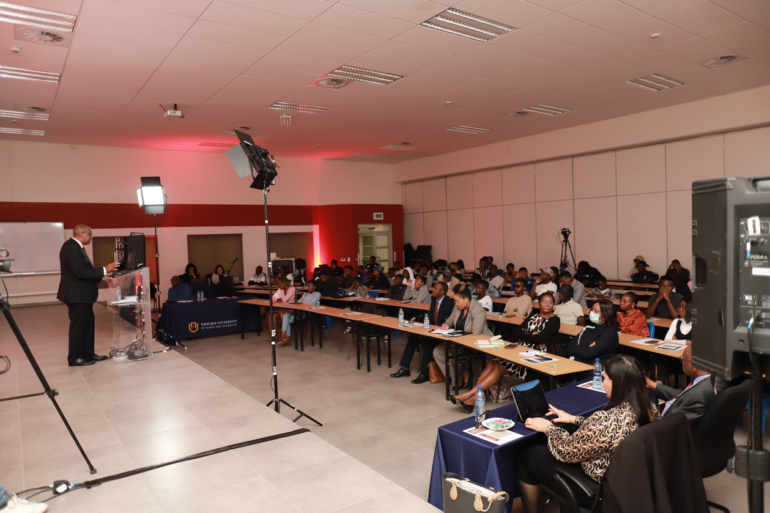Omanyano ovanhu koikundaneki yomalungula kashili paveta, Commisiner Sakaria takunghilile
Veronika Haulenga
Omanyano ovanhu koikundaneki yomalungula kashili paveta, Commisiner Sakaria takunghilile
Veronika Haulenga
Listeners:
Top listeners:
-
play_arrow
Omanyano ovanhu koikundaneki yomalungula kashili paveta, Commisiner Sakaria takunghilile Veronika Haulenga
Bank of Namibia hosts public lecture on financial inclusion in rural areas


The Governor of the Bank of Namibia, Mr. Johannes !Gawaxab, delivered a public lecture at the Namibia University of Science and Technology (NUST) in Eenhana, Ohangwena region. The lecture, under the theme “Unlocking Opportunities for Rural and Informal Sector Development through Financial Inclusion,” highlighted the critical role of financial inclusion in transforming Namibia’s rural economy.
In his address, the Governor drew lessons from the Bank’s 2023 Annual Symposium, held under the theme “Transformation of the Rural Economy in Namibia.” The symposium focused on rural economic development, sustainable agriculture and youth development. The symposium further emphasised the need for effective economic development endeavours in rural regions to stimulate economic growth and empower communities.
During the lecture, the Governor emphasized the importance of providing individuals and businesses with access to formal financial services, such as savings accounts, credit, and insurance. He highlighted numerous studies that demonstrate the positive impact of financial inclusion on food security, health outcomes, and educational attainment, underscoring its potential to transform lives and build a more prosperous future for all Namibians.
The Governor delved further into the microeconomic benefits of financial inclusion, explaining how access to credit and savings accounts can empower individuals and small businesses to invest in productive activities, generate income, and create jobs. He also noted the role of insurance products in mitigating financial risks and preventing people from falling back into poverty due to unexpected shocks. Shifting focus to the macroeconomic level, the Governor noted that financial inclusion contributes to economic growth, reduces income inequality, enhances investments in infrastructure and makes growth more inclusive and equitable.
Governor !Gawaxab emphasised that the northern regions of Ohangwena, Omusati, Oshana, and Oshikoto, which depend largely on subsistence farming and small-scale agriculture, are especially susceptible to adverse climate events such as droughts and periodic floods. He further underscored the importance of developing a resilient rural economy through financial inclusion, which provides the essential resources and tools needed to mitigate risks and adapt to changing conditions.
Namibia confronts a similar crisis, with the President recently declaring a state of emergency as increasing number of Namibians experience food insecurity and seek drought relief. According to the Namibia 2023 Vulnerability Assessment and Analysis report, approximately 579,000 people, or 22 percent of the population, are experiencing severe acute food insecurity and require urgent intervention to address food shortages and safeguard livelihoods. The report forecasts that by March 2024, this figure could rise to 26 percent of the population, affecting around 695,000 people. Additionally, the northern regions of Namibia experience periodic flooding. The 2009 flood affected over 677,542 people, led to the relocation of over 54,581 individuals, and resulted in 105 flood-related deaths.
Despite Namibia’s significant progress in achieving financial inclusion, now estimated at 78%, these efforts have not translated into widespread benefits, particularly in rural areas. A substantial portion (59.3%) of the rural population remains excluded. Many Namibians (62%), especially those living in rural regions, still rely primarily on cash for income and payments. This reliance often requires traveling long distances to the nearest financial institutions or ATMs, which can be costly and further discourage the use of formal banking services. Additionally, carrying large amounts of cash poses significant security risks, including theft and robbery. High fees and charges associated with day-to-day interactions with the formal financial system also deter customers from engaging with formal financial institutions.
A key highlight of the lecture was the introduction of the Bank’s Instant Payment Project. This innovative initiative aims to enhance financial inclusion by enabling efficient, instant, and inclusive transactions accessible on any device, including non-smartphones. The Governor explained that this solution, set to launch in 2025, would significantly reduce the time and cost associated with traditional banking services, making financial transactions more accessible to rural and informal sectors.
The Bank of Namibia’s commitment to unlocking opportunities for rural and informal sector development through financial inclusion is unwavering. Governor !Gawaxab emphasized, “Financial inclusion is not just about providing access to financial services; it is about empowering individuals and communities to achieve sustainable growth and development. We must ensure that no one is left behind in our journey towards a more inclusive and prosperous Namibia.”
Following the lecture, the Governor held a stakeholder engagement with industry representatives from the region. The discussion focused on unpacking the Bank’s mandate, recent domestic, regional, and global economic outlook, as well as updates on the SME Economic Recovery Loan Scheme and the Bank’s digitisation agenda. This engagement underscored the Bank’s commitment to transparency and collaboration with local stakeholders to drive economic development.
The public lecture was well-received by attendees, including students, faculty, and local business owners, who appreciated the Governor’s insights and the Bank’s proactive measures to foster financial inclusion and economic development in rural areas.
Written by: Staff Writer
Bank of Namibia Economic development Eenhana financial inclusion informal sector development Johannes !Gawaxab Namibia University of Science and Technology NUST OHANGWENA REGION public lecture rural economy Sustainable Agriculture Youth Development
Windhoek Weather
Most popular

Mbumba signs off new benefits for retired political office bearers

Former FNB employee arrested after defraud pensioner off N$215, 000

Namdia Heist: More questions, lots of confusion

Omuhwahwameki Michael okuunganeka oshikonga shoku patitha oostola dho Rani moshilongo ashihe.

Windhoek woman loses N$60,000 to fraudsters
Copyright 2025 Future Media (Pty) Ltd | Website by Digital Platforms
Tel: +264 83 000 1000 | Email: news@futuremedia.com.na





